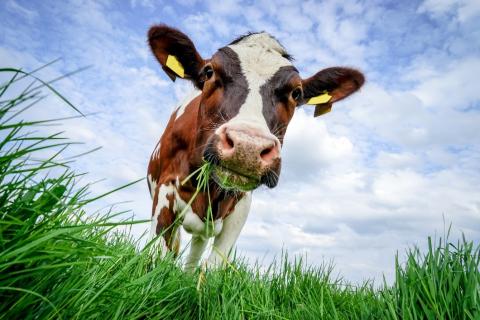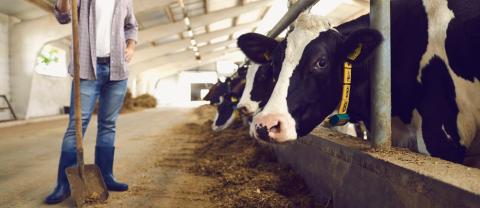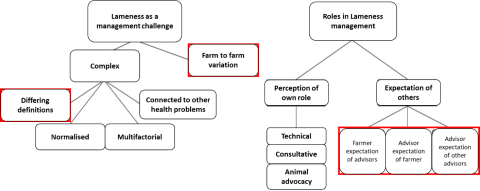13 April 2022
Dr David Cutress: IBERS, Aberystwyth University.
- Lameness has consistently been amongst the highest impacting diseases of dairy cattle in the UK.
- Average levels of lameness have remained high regardless of resources and programmes aimed at management and training for its reduction on farms.
- Methods of agricultural knowledge exchange require further consideration and analysis to improve resources and initiative messages towards impacting farm-level practices.
The lameness problem
Lameness is known to be one of the most common diseases in the dairy cattle industry; having huge impacts on animal productivity, welfare and of course economics. Indirectly, lameness and other diseases also have impacts on the environmental efficiencies and carbon footprints of farms, suggesting disease control is an ever-important consideration for a sustainable future. Based on various impacts, the AHDB estimates that the current cost of lameness is around £180 per cow. Despite such figures, it has been noted that accurate cost analysis is even more complex, with a single lameness’ case ranging in costs from around £50 - £400 depending on the location and calculation methods used. This suggests that the financial impacts could be more than twice as high as those noted by AHDB. Recently, literature focus has evaluated the best detection and classification methods for lameness, inclusive of technologies, towards reducing labour and improving automation. Lameness as a term, refers to a clinical sign rather than a single disease and therefore presents with issues in conceptualisation. This is worsened when considering the differing origins and sources associated with lameness. As a result, this has an impact on the complexity surrounding the treatment options and management strategies used. The complexity of lameness is such that following recent analysis, over 128 different factors affecting/leading to lameness were identified. Another of the re-occurring areas of research interest has been on understanding and improving farmer knowledge, training, awareness and decision-making surrounding lameness on farms. It is noted that when this is made a farmer focus, it can lead to improved uptake of efficient lameness control strategies and improved animal health, as well as promoting welfare prospects at farm level.
Known solutions
There are several implicated actions and solutions relating to controlling cattle lameness, many of which, inclusive of technologies, have been previously discussed. Generally; through providing good quality surfaces throughout barns, milking areas and yard transitional areas; improving hygiene and biosecurity; as well as maintaining high overall animal health are most commonly effective in reducing lameness occurrences. However, much previous research has noted that farmers often underestimate the true frequency of lameness on their farms via standard observations. Much of the systems suggested by lameness health programmes aim to remove underestimation by collaborating in diagnosing lameness directly or through training farmers in more objective robust methods to diagnose lameness. This suggests systems that ensure farmers receive improved targeted knowledge exchange might help farmers to feel encouraged to trust and incorporate advice, where they may need it, in order to improve animal welfare and reduce on-farm disease risks. The Healthy Feet Programme from AHDB is the key lameness control programme in the UK. These incorporate actions and advice from trained and approved Mobiltiy Mentors and assessment tools to enable management changes on a farm. Whilst these and other such schemes can be seen as a positive step concerning lameness, are these really how farmers learn best?
Knowledge exchange and awareness
The interactive exchange and development of knowledge is a complex process that occurs at multiple levels within a sector or system, for example between policymakers and scientific researchers or between farmers and veterinarians. Whilst it is vital that messages and knowledge are transferred across the agricultural sector concerning lameness, the relative lack of movement in lameness figures across the UK over time, suggest that current strategies may not be particularly effective at this. Barriers to any change in practices at farm-level, alongside knowledge exchange (KE) understanding and acceptance have been repeatedly noted in livestock agriculture; with specific dairy health studies demonstrating different impacts and farmer attitudes when comparing the use of rewards and penalties. Furthermore, factors such as uncertainty of a farmer’s own ability to accurately assess clinical signs, mistrust and dissatisfaction with animal health authorities’ policies and belief that suggested controls will be ineffective can all be barriers to disease control. Broad barriers which may be impacting successful KE have been identified with some of these having been succinctly separated into issues that impact;
- Individual-level
- One’s own experience and ability to assess evidence
- One’s trust in the other communicator involved in any exchange
- Having a negative attitude towards change in general
- Organisational level
- Unsupportive cultures for exchange
- Competing interests from different levels of the exchange
- Directly related to communication
- Poor choice of messenger used
- Information overload
- Wording and language used
- Information lacking direct actionable messages
- Relating to time or timing
- Differences in communicators considered timeframe
- Need for immediate decisions in some instances
Whilst the levels above for KE were related to exchanges between researchers and producers in a human health care situation they have important implications for transfer to agriculture. Livestock disease prevention involves balancing farm economic, social, environmental and welfare goals given the income, labour, resources and support available to farmers. Alongside, such general issues it is clear that there is a requirement for tailored knowledge surrounding specific systems of practice in the UK such as outdoor, grazing heavy dairy systems, compared to systems that are more consistently indoor or conventional vs organic; each of which will have different disease impact implications. Studies highlighting specific barriers to successful KE within the confines of dairy lameness include a study across farmers, veterinarians and hoof trimmers in the US. In this, it was recognised that farmers believed there was insufficient communication and exchange between different farm advisors (in this case veterinarians and hoof trimmers) towards ensuring consistent messages are delivered to farmers on best management approaches. This was highlighted in the studies map of thematic analysis as ‘farm to farm variation’ and ‘differing definitions’ featured as key challenges in this area (see below). This is interesting as the UK and Spain centric study of dairy farmers also highlighted that value of information and knowledge given by vets was most important from a farmers perspective over any other levels of knowledge exchange interactions (such as the internet). As such, this offers weight to the importance that veterinary specialists’ opinions and messages provided need to be consistent and echoed across an exchange framework.
Specific KE strategies which have been heavily utilised and assessed with regards to agricultural activity include the following:
|
KE strategies/systems identified in relation to farmers/agriculture |
Brief description |
|
Stable Schools |
5 – 10 farms meet, design and discuss strategies for particular issue taking onboard advice and reviewing impacts. ‘Facilitator’ assists communication |
|
Farmer field schools |
Groups of farmers meeting regularly, often on demonstration farms to learn from each other through discussion and practice |
|
Participatory action research (PAR) |
Encourages members of the community under consideration (eg. Farmers) to have the biggest role in collaboratively directing and informing research |
|
Participatory Guarantee systems (PGS) |
Locally focused quality assurance systems. They certify producers based on active participation of stakeholders and are built on a foundation of trust, social networks and knowledge exchange |
|
Peer review |
Farmers discuss knowledge with other farmers in a peer review system |
|
Newsletters |
Written information from agencies or groups aimed at informing those who read them |
|
Online forums |
Essentially peer review but wider reaching |
|
Social Media |
Information presented via various social media platforms either in a blanket or targeted manner |
|
Focus Farms |
Practical example farms which aim to put knowledge into practice and facilitate others viewing and evaluating the outcomes |
Of these methods, stable schools have been noted to have a good potential for complex multi-factor disease KE and should work well with lameness. Furthermore, research on farmer adoption of disease prevention and control management strategies indicated increases in uptake when more personal approaches; such as participation in learning events or direct communication with farm advisors were included. Despite these initial pieces of evidence, a recent review exploring the importance of collaborative processes in translating knowledge and practices via KE stated that currently there is not enough known about the best strategies with regards to agriculture. Similarly, a study on farmer behaviour change concerning cattle disease in 2021 highlighted a lack of study robustness in previous KE literature and a need for future research to employ more defined analysis frameworks. Improving such analysis should allow future research to evaluate the best routes to communicate with farmers with regard to behaviour surrounding disease control. To assess the role of such strategies further a European Innovation Partnership (EIP) project across Wales is looking at how peer to peer group farmer discussions work alone or alongside specialist advice (similar to a stable school approach). The findings of the project could assist agricultural bodies and policymakers in refining future livestock health and welfare programmes towards improving outcomes. Whilst this article focuses on lameness, another key area of note where knowledge exchange and interaction could be improved within the UK dairy cattle industry is in calf management. Calf mortality rates are known to be crucial welfare and economic issues within the sector. Despite this, studies have indicated a lack of farmers seeking veterinary involvement in the day-to-day health decisions of youngstock. Any lessons in improving knowledge exchange and facilitating improved farmer/farm advisor interaction in lameness could, therefore, play important roles in the design and consideration for future calf health advice resources and programmes as well.
Summary
Lameness is a detrimental disease of high welfare and economic concern within the dairy cattle sector. Initiatives, programmes and policies have all sought to address this issue with relatively little success. Research has discussed barriers to the transfer of knowledge between levels of the agricultural chain inclusive of policymakers, advisory bodies, farm advisors and farmers themselves. If such knowledge transfer and barriers to transfer can be understood more comprehensively this should improve the future success of strategies attempting to combat this multifactorial disease within this sector, whilst possibly having transferability to other concern areas regarding knowledge exchange in agriculture more generally.
If you would like a PDF version of the article, please contact heledd.george@menterabusnes.co.uk



